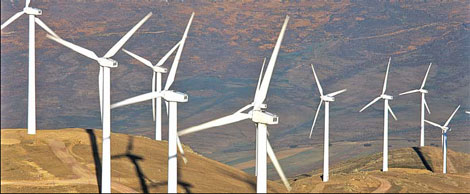News
Renewable energies boost the grid
(China Daily)
Updated: 2010-05-03 07:13
 |
Large Medium Small |
|
Wind farms will provide much-needed electricity in Kenya, which has abundant high-speed winds. |
The Ministry of Energy has made significant strides in the promotion, development and utilization of renewable energy resources, resulting in an increase in the proportion of its contribution in meeting the country's energy demand. This has significant socioeconomic benefits, such as poverty alleviation and the improvement of the welfare of Kenyans and the country at large through income generation and employment and wealth creation.
Renewable energy technologies that have contributed in making a positive impact include solar, wind, micro hydro and modern biomass (co-generation and improved stoves).
As is fitting for a country so close to the Equator, solar energy is abundant in Kenya and offers a unique opportunity for a vibrant solar energy market that provides cheap electricity to homes and institutions, particularly those that are far from the national grid, in the Arid and Semi Arid Land (ASAL) areas. Although not yet fully exploited because of the initial capital outlay required to harness it, the private sector has done much to promote and install solar electricity (photovoltaic or PV) generators in the country, although data on installed capacity is as yet unavailable.
Important strides have been made in implementing a solar electricity program in schools, health centers and dispensaries in remote areas far from the grid. This PV program was initiated in 2005 and to date has benefited 134 boarding secondary and primary schools, health centers and dispensaries in 20 ASAL districts at a cost of $6 million.
Leading by example, the government will also introduce mandatory solar water heating in designated residential and commercial buildings within Kenya's municipalities, to enforce the usage of solar water heating and natural ventilation in all new buildings where technically feasible. As well as providing relief to the grid, solar water heating will reduce the oil import bill, develop the local solar industry and create employment. Water heating regulations have been developed and all formalities regarding by-laws approved.
The wind factor
A national Wind Atlas was prepared in 2001 with indicative wind regimes based on synoptic weather stations data. This was updated in 2005 using satellite data provided by several agencies including National Aeronautical and Space Administration (NASA) and ground validation. Since then the Ministry of Energy has installed 20 wind masts and data loggers to enable collection of more wind data to augment the wind atlas.
A new project which aims to acquire more data at reasonable heights (40 m) that will be used to update the wind atlas to provide a more realistic wind map to guide investors to sites with good potential for wind power development started in 2009. Under this project, masts and data loggers will be installed at 33 sites across the country to generate wind regime data to enable private investors to make informed decisions on wind power generation. This will be extended in the coming years.
"We have just signed a contract with the Lake Turkana Wind Consortium for 300 mW in Northern Kenya, and there is enormous potential for tidal generation," said Energy Minister, Kiraitu Murungi, "We already have a proposal from an Israeli investor to generate electricity from the sea waves near Malindi, and invite more investors to come on board.
"To encourage accelerated investment in renewable energies, the Minstry has formulated new feed-in tariffs on wind, geothermal, biomass, and small hydropower systems. Under this policy Kenya Power and Lighting Company Ltd. is required to sign long-term Power Purchase Agreements with investors," Murungi concludes.
(China Daily 05/03/2010 page19)








